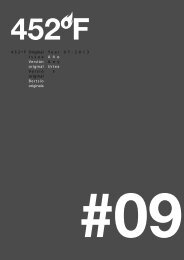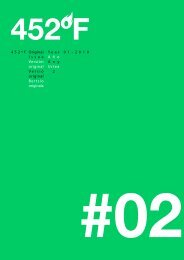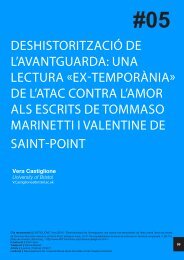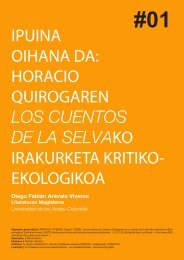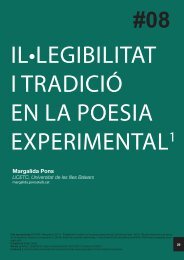03 - 452ºF
03 - 452ºF
03 - 452ºF
You also want an ePaper? Increase the reach of your titles
YUMPU automatically turns print PDFs into web optimized ePapers that Google loves.
(Genette, 1982: 451). In this way, the palimpsest is also polyphonic,<br />
in Bakhtin’s sense of the word, as it consists of many voices besides<br />
that of its most recent author.<br />
Another theorist who developed notions of intertextuality is the<br />
Moroccan writer and literary critic, Abdelkébir Khatibi. Like his<br />
contemporary Homi Bhabha, Khatibi is interested in the cultural<br />
specificity of the intertext which, in his view, has been mostly<br />
overlooked (see Dobie, 20<strong>03</strong>). Influenced by Jacques Derrida’s<br />
philosophy of différence, Khatibi sees the text as an encounter<br />
between specific cultural and linguistic influences which, at their<br />
point of meeting, mingle with one another and metamorphose. This<br />
transformative encounter creates the possibility of a pensée-autre,<br />
or the possibility of «thinking otherwise», where static binaries are<br />
dissolved and dialogue becomes possible. In Maghreb pluriel (1983)<br />
he explains the concept of pensée-autre as a kind of plural thought<br />
that originates at sites of cultural diversity like the Maghreb. This<br />
plurality is viewed by Khatibi as a source of vitality and so to deny it<br />
is destructive to the society in his view. According to Khatibi, another<br />
integral element of pensée-autre is its marginal nature—as a liminal<br />
space where the self and the other interact and transform one<br />
another. Hence, the intertext is always unfinished and in the process<br />
of becoming. By extolling the virtues of open and unfixed thought,<br />
Khatibi criticizes notions of static social and textual binaries—much<br />
like Bakhtin and Kristeva did in their respective critiques of formalism<br />
and structuralism—while the unfinished quality of pensée-autre also<br />
allows for diversity since identity is not formulated on mythic ideas of<br />
the past: «If we accept the possibility of an identity that is no longer<br />
fixed to the past, we may achieve a more just conceptualization<br />
of identity that is in the process of becoming; that is to say that<br />
identity is a heritage traces, words, traditions, transforming over time<br />
which is given to us to live out, with one another» (Khatibi, 1990:<br />
149; my translation). Calling for an acceptance of the other within,<br />
Khatibi claims that we might finally move towards a more truthful<br />
approach to the idea of identity. This acceptance would be based on<br />
an understanding of our innate heterogeneity and would require a<br />
rejection of identity constructs that rely on comparisons of self versus<br />
other or East versus West. Residing in the gap between cultures<br />
and languages, he argues that the Maghrebi author must constantly<br />
destabilize meaning and deconstruct unitary ideas through the social<br />
text.<br />
Building on the above approaches to intertextuality, and introducing<br />
Edouard Glissant’s (1981; 1989) contribution to debates about<br />
hybrid identities and texts, Françoise Lionnet describes métissage<br />
as a feminist praxis that cannot be assimilated into a fully articulated<br />
theoretical system. According to her, métissage is a kind of bricolage,<br />
in the sense elaborated by Claude Lévi-Strauss. However, it<br />
«Je suis un cowboy du Far West»: A study of textual métissage in Djanet Lachmet’s autobiographical novel Le Cow-boy (1983) - Caroline Kelley<br />
<strong>452ºF</strong>. #<strong>03</strong> (2010) 85-101.<br />
95



